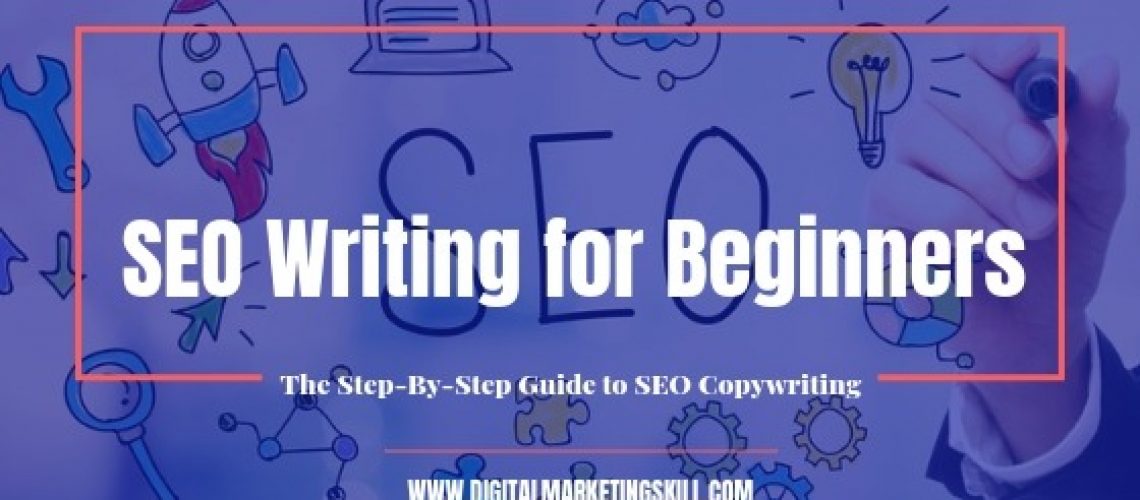So, you have submitted your website to Google for crawling and indexing, your XML sitemap and technical SEO are up and running and you’ve also started churning out content on the website, but somehow, the contents are not ranking on Google search engine.
And this may have been on for months now.
The reason is simple. You are not leveraging effective SEO writing strategies that can help optimize your on-page SEO and make your content more rankable and visible on search engines.
With traffic from search engines outpacing traffic from social media and growing interest in voice-activated searches via speech-enabled tools like Alexa and Siri, writers need to understand the importance of SEO (search engine optimization) and how it influences the content they create.
But search engine optimization is not easy. That’s one of the main reasons why so many marketers avoid it as a strategy.
In a recent survey from Clutch, it was reported that SEO is not the most liked technique for boosting rankings. Only 44% of digital marketing channel businesses invest in it.
Instead, marketers prefer social media marketing (81%), promotion through a website (78%), and email marketing (69%).
But we have to keep in mind that SEO encompasses social media marketing and website promotion. Whatever you do, there’s no chance to avoid it. The way your website ranks in the search engine is crucial to conversions.
And so, understanding SEO is crucial for a long-term career as a content writer.
Get 50% Discount to Master ALL Aspects of Digital Marketing That Can Earn You $2,500 - $5,000 a month (Even if you are a complete beginner!)
Our students that intentionally implement what they learn from our digital marketing course make back the entire course fee within a single month or more after completing our course because our course gives them many income generating options with unlimited earning potential with no age or location barrier. The best part is no technical skills are required.
An opportunity to change your lifestyle and make money working from anywhere in the world. The results our students get from our digital marketing course prove this could be applied to any market or country and that it is designed for any skill level and work background.
*By signing up, you agree to our privacy policy and terms of service.
Knowing how to maximize your content’s potential for search engine discovery can make the difference between mediocre success as a writer and a high-paying career as an in-demand digital marketing creative.
Luckily, in this SEO writing beginner post, you will find a step-by-step guide on SEO strategies and tips to optimize and make your content more visible and rankable by search engines.
This beginner’s guide is designed to answer three questions:
- What is “SEO content”?
- What types of SEO content are there?
- What is a good SEO content strategy?
- SEO writing tips
And lots more.
Before we dive straight into it, if you are still struggling with other aspects of search engine optimization (SEO) like technical, off page SEO and how to get quality and relevant backlinks linking to your content, then you need to register for our next digital marketing training.
These are some of the most important ranking signals on Google to help you get your website ranking on the first page for your selected keywords.
Click here to learn more about the training.
Now that you have done that, let us get started on how you can use SEO writing to rank your web pages and website.
First things first…
What Is SEO Content?
To understand what marketers mean by SEO content, it’s helpful to break down the phrase into its component parts:
“SEO” refers to search engine optimization or the process of optimizing a website so that people can easily find it via search engines like Google.
By “content,” we mean any information that lives on the web and can be consumed on the web (more on the various types of content below).
So, putting these two concepts together: SEO content is any content created to provide value and attract search engine traffic.
I’m not going to tell you everything you need to know about optimizing your content for search engines here; that’s a whole ‘nother guide. But here’s a super-quick refresher on what you’ll need to do to SEO your web content:
- Keyword Research: If you want to generate traffic through a search, it’s best to do keyword research before you start writing. This way, you can focus on keywords for which a certain amount of search volume already exists – in other words, write about topics that people are already searching for information about.
- Keyword Optimization: Know where and how to use keywords in your content for maximum searchability.
- Content Organization: The content on your site should be organized logically. This is not only good for SEO, it also helps visitors on your site find other related content easily. (The longer they stay on your site, the better.)
- Content Promotion: Increase visibility to new content you create by sharing it on social networks and building links to your content (both internally and from external sites).
Why Is SEO Content Writing Important?
SEO content writing is very important for businesses that want to have a strong online presence. It means creating high-quality, interesting content that is optimized for search engines. This helps improve your visibility online and drive more people to your website.
When you understand your target audience and create content that meets their needs, you can build trust, get more customers, and make your brand an expert in your industry. SEO content writing is crucial for any business that wants to succeed online.
Types of SEO Content
SEO content can include any of the following:
- Product Pages – These are the bread and butter of any retail e-commerce site. A good product page can serve as both SEO content and a PPC landing page.
- Blog Posts – A blog is one of the easiest ways to create a regular stream of SEO content. In general, blog posts are more engaging and more likely to attract links than product pages, so they can be a great way to build some authority for your site. (Keep in mind that blogs are very flexible, and you can use them to host any of the below types of content in this list.)
- Articles – Think news article, interview, or feature piece. This is the main kind of content you’ll find on most newspaper- or magazine-style websites.
- Lists – A list is just a kind of article, but framing it as a list (such as “20 Free Google Marketing Tools”) makes it easier to scan. These types of titles also seem to be more clickable when found in search results or in social media feeds.
- Guides – A guide is a longer piece of content that explains in detail how to do something. (Guides are often broken up onto multiple web pages, though it’s a best practice to allow users to view long content as a single page if they wish.) You can post a full guide on your website, or you can post a summary or excerpt, requiring visitors to fill out a registration form to read the full guide. This can be a good way to generate leads, but keep in mind that putting up a registration wall will likely reduce the amount of SEO traffic you can drive to that guide because there is the possibility for a bounce rate spike when with people who are wary about leaving their details behind.
- Videos – In general, there are fewer videos on the web than pages of text; consequently, it can be easier to rank on the first page for a competitive keyword by creating a video instead of an article. Depending on what type of site or business you run, videos can be a great way to attract and reach an audience. Consider creating video tutorials of how to use your products. Or illustrate a process that is related to your business – for example, a plumber could make a video showing how to fix a leaking pipe.
- Infographics – Infographics, or large-format images that contain a lot of data (often in the form of graphs or charts) on a single subject, can rack up a lot of page views and links. However, because so much of the content is embedded in the image and therefore not readable as text by search engines, it’s important to carefully optimize the rest of the page.
- Slideshows – A slideshow is a way to display a series of related images. Sometimes pictures are more important than text – say you’re trying to show what all the stars wore to the Oscars. Here again, SEO of your title, captions, image file names, and so on is important because there is less for the search engines to “read.”
- Glossaries – It’s no news again that more people use Google to look up terms than they use a dictionary. (Do you even know where your dictionary is?) If you work in a specialized industry, a well-built-out glossary can be a good way to capture some search traffic. Think cooking terms, medical terms, fashion terms, architectural terms.
- Directories – A directory is a useful taxonomy of links to sites or resources around a given topic. For example, a perfume blog might create a directory of places to buy perfume, from major department stores to independent shops around the country.
These are just some of the basic types of SEO content, but don’t let this list limit you – the possibilities are virtually endless.
What is a Good SEO Writing Strategy?
If you’ve been randomly producing content, hoping and praying that some of it eventually ranks, it’s time to buckle down and commit to a more methodical SEO content strategy for the web.
Here are four steps to defining and refining your SEO content strategy:
Define your goals
First, determine your goals as a website or business. Are you looking to drive sales through your website? Do you monetize your site via ads and therefore just want to increase traffic and return readership?
Your goals will determine what types of content you should focus on.
If you’re primarily trying to drive product sales, your primary focus should be attractive, informative product pages that are optimized for both search and conversions.
Your secondary focus could be helpful blog content that illustrates when and how to use your products, linking to those pages where relevant (it’s best if your blog is not entirely self-promotional, though).
If your site operates on an advertising model and the goal is to attract new readers through search, you’ll want to focus on rich content (such as long-form articles or video resources that are informative, entertaining, or both) with “stickiness” (“sticky” content keeps visitors on your site longer or encourages them to return).
Consider your audience
Know your audience – surveys and your analytics software can help you get a better picture of your typical visitor or client.
Consider developing marketing personas, or characters that represent your ideal site visitors and customers. Then think about what kinds of content those personas would be looking for.
For example, if you operate a B2B website that targets C-level executives, you might want to create high-level white papers that can be downloaded and saved to read later.
If your business targets teens and tweens, you might want to focus on frequent updates with less text and more images and video. You’ll also want to be sure your site is optimized for mobile usage.
Create an editorial calendar
Once you have an idea of who you are targeting and why, you can start to build out an editorial calendar. An editorial calendar is a schedule that dictates when you will publish new content and what type of content it will be.
This will help you stick to a regular schedule (it’s especially important to create new content regularly if you have a blog), as well as prevent you from scrambling to come up with a topic for new content at the last minute.
A few tips for creating and adhering to an editorial calendar:
- Use Outlook (or Google Calendar) – Share the editorial calendar with your whole marketing team. Set up reminders for authors so they get a notification when a deadline is coming up.
- Consider creating ongoing features – For example, a food blog might do a meatless recipe every Monday. Many blogs do link roundups once per week. Create a category page for each ongoing feature, so visitors can find all of your Meatless Monday recipes or link roundups in one place.
- Give yourself plenty of lead time- when producing more complicated types of content, such as videos and infographics. These often need multiple rounds of edits to perfect and can be more complicated to optimize for search.
- Don’t plan too far out in advance – Calendars often get derailed after a month or two, due to changes in marketing goals, budgets, or staff, so don’t try to plan out a schedule for the next year and risk wasting a lot of time and effort.
Analyze and Measure
Finally, stay on top of your site’s analytics. Regularly analyze your SEO content to see what’s working and what isn’t.
Good measures of success and engagement include page views, links, comments (on blog posts and some other types of content), social shares (Facebook likes, tweets, etc.), and conversion rates. Your analysis should have two goals:
- Study your successes so you can repeat those strategies – Look for patterns. Does your audience love videos? Then make more videos! Adjust your editorial calendar going forward so you can focus more time and effort on the content types that resonate.
- Carve out time for updating and improving older SEO content – If you tried to optimize an article for a certain keyword, but it’s getting more traffic for a different variation of that keyword, then go back in and re-optimize it for the new keyword. You might be able to significantly increase traffic by putting that keyword in the title, for example.
SEO Content Writing Tips
In this section, you are going to learn the steps on how to optimize your content for SEO from our 25-point SEO writing checklist.
Before your start:
1. Know the goal
Before you start writing a piece for SEO, you need to know its purpose. Is it top-of-funnel content or bottom? What action is the content trying to inspire?
2. Know the audience
Equally important to knowing the goal, is knowing who the content is for.
When you know who you’re writing for, it’s much easier to write in a relatable and engaging way. If you’re not sure who your audience is, check out our post on developing audience personas.
3. Know the headline
Have a headline in mind before you start writing. This will help guide you through writing and structuring the piece.
For Writing:
4. Write 1000+ words
In most cases, SEO content should be at least 1000 words. Apart from some product descriptions and category pages, content under 1000 words risks being too shallow.
5. Use an active voice
Using an active voice keeps readers interested and engaged.
6. Write unique content
Google prioritizes unique content. Don’t copy content or reuse product descriptions given to you by a manufacturer.
7. Short and sweet sentences
Concise writing is easier and more interesting to read. When editing your content, look for unnecessary words that can be removed.
8. Provide data sources
If you provide a stat or quote, be sure to provide a source for your data. Not only will your readers appreciate knowing where your stats come from but linking to high-quality sites improves your SEO.
9. Use sub-headings
Readability is an important part of SEO writing. Subheadings break up your content and make it easier to read or skim.
10. End with a CTA
Remember the goal of the content? Include a call-to-action at the end of the post to support that goal.
Keywords Incorporation:
11. Add the primary keywords at least once
It’s no surprise that you should use the keyword you’re trying to rank for at least once in the content.
12. Use the primary keyword in the:
- Title
- URL
- First 100 words
- Heading
- images
- meta description
13. Add secondary and semantic keywords
Avoid using the same keyword over and over by including synonyms and semantically related words. Google knows that these words are related, and it also makes your writing sound more natural.
14. Use keywords naturally
Google is getting better and better at detecting unnatural keyword usage.
Links:
15. Link internally
Keep readers engaged for longer by including internal links to relevant pages.
16. Use keywords in the anchor text
When linking internally, use relevant keywords as the anchor text.
17. Link to high-quality external sites
Add outbound links to other sites to give credit and cite sources.
Meta-data & URL:
18. Add a meta description
While a meta description isn’t a technical ranking factor, it impacts whether a searcher clicks your link or not.
19. Write meta descriptions under 300 characters
Meta descriptions have a character limit. If you go over 300 characters, then the last sentence might be cut off.
20. Use the primary keyword in the meta description
Including the primary keyword in the meta description reinforces what the page is about.
21. Use the primary keyword in your image alt tags
Including the primary keyword in the image alt tags improve SEO. Pro tip: Also save the image file with the primary keyword in the name.
22. Use the primary keyword in the URL
Including the keyword in the URL shows both search engines and readers what your page is about.
Finalizing:
23. Write another headline
Don’t settle for the first headline that comes to mind. Come up with a few ideas and then pick the best.
24. Do a final edit
Once you’re ready to publish, do one last edit to double-check spelling and grammar. Tools like Grammarly can help with this.
25. Check your links
While you’re doing the final edit, check your links to make sure they work and point to the right website.
Difference Between SEO Writing and Content Writing?
The difference between SEO writing and content writing lies in their primary goals and approaches. SEO content writing is specifically designed to rank well in search engine results pages (SERPs) and drive organic traffic. It focuses on optimizing content for search engines, using specific keywords and phrases, and may follow a more formulaic approach.
On the other hand, content writing is focused on engaging the reader, establishing the brand as a thought leader, and meeting the needs and interests of the target audience. It is more creative and flexible in its approach, using storytelling and anecdotes.
While SEO content writing is developed for readers, creative content writing is created simply for the enjoyment of readers.
Therefore, the key difference lies in their goals, audience approach, and writing style. Both are valuable skills in the modern world and understanding the variances between the two can help in creating effective and engaging content.
FAQs
How Do I Write SEO-Friendly Content?
To write SEO-friendly content, focus on using relevant keywords, meta tags, and header tags. Make sure your content is well-structured, easy to read, and provides value to your audience. Use tools like Google Keyword Planner to find relevant keywords and optimize your content accordingly.
What Are Some Common SEO Writing Mistakes?
Common SEO writing mistakes include using too many keywords, not using meta tags, and not optimizing images. Additionally, using low-quality or thin content can also harm your SEO efforts. Make sure to avoid these mistakes and focus on creating high-quality, engaging content.
How Do I Measure the Success of My SEO Writing?
To measure the success of your SEO writing, track your website’s traffic, engagement metrics, and conversion rates. Use tools like Google Analytics to monitor your website’s performance and adjust your SEO strategy accordingly. Additionally, use keyword tracking tools to monitor your keyword rankings and adjust your content accordingly.
Conclusion
We’ve used these SEO writing strategies to reduce our website’s bounce rate, increase website ranking and also pimp our blog’s traffic by over 103%.
Even if you don’t achieve the same growth rate, you will generate more traffic, improve your brand, and fall in love with content marketing.
When you register for our digital marketing training, you will be able to practically learn these SEO writing tips and also optimize your website for technical, off page and link building SEO strategies.
Click here to learn more about the training.
More Resources
12 Ways Digital Marketing Can Help Boost Your Business
8 Ways Nigerian Businesses Use Social Media To Grow Their Business
Why is a website the most important part of Digital Marketing?








